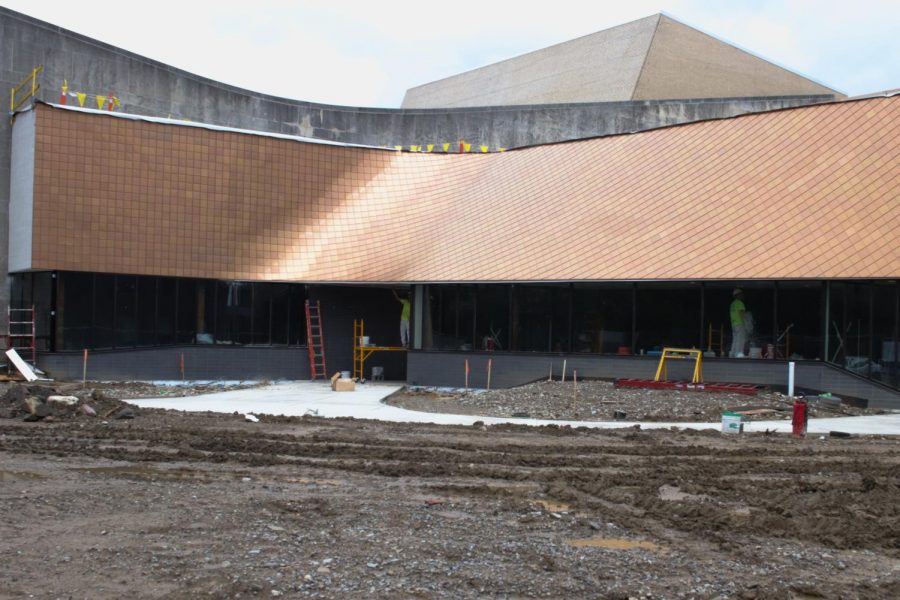New Eric Baker Nord Performing Arts Annex Offers Top-of-the-Line Performing Spaces, Needed Facilities
Construction on the Eric Baker Nord Performing Arts Annex is nearing completion. The Theater department is set to stage “Cabaret,” its first mainstage show in the new space, in early December.
Hall Auditorium is getting an upgrade that will revolutionize the future of theater at Oberlin.
A semester after the acclaimed success of Angels in America, the epic two-part performance that received high praise across campus last spring, the renovations and expansions of the Eric Baker Nord Performing Arts Annex are finally coming to fruition. For some, this project represents a decades-long desire to improve both the quality and quantity of performance spaces on campus.
“There are some faculty that consider this project yet another iteration of ideas that have been gestating for 25, 30 years,” said Managing Director of Theater, Dance, and Opera Eric Steggall.
However, plans for this particular project, which also include much-needed renovations to Hall Annex, began about six years ago. Construction started over a year and a half ago, and the project has progressed significantly in the last 12 months.
The new building is situated between Hall Auditorium and the Peter B. Lewis Gateway Center, which houses the Office of Admissions, StudiOC, and The Hotel at Oberlin. Though the basic function of the new space is to provide a much-needed third performance space to complement Hall Auditorium and the Kander Theater, the new performing arts annex presents an additional range of opportunities for members of the College, Conservatory, and community at large.
Among the new offerings in the space are an attractive metal-faced exterior, a brand-new lobby, a costume shop, a scene shop, and rehearsal spaces. The building also contains new bathrooms for patrons and two new dressing rooms for performers. For those familiar with the prior behind-the-scenes facilities of Hall Auditorium and Hall Annex, including Kander Theater, these updates are nothing short of monumental.
The crown jewel of the project is the Irene & Alan Wurtzel Theater, a highly-adaptable performance space that will house an audience of 250–300 people. The addition of this theater space is significant in providing a performing space that is sized midway between 501-seat Hall Auditorium and 75-seat Kander Theater. Additionally, the array of theater setups and possible performance styles provided by the Wurtzel poses a welcomed opportunity for new curricular offerings to the faculty of the Theater department.
“The curricular challenge of moving, acting, and designing in a space that is so fluid really challenges us as a department to grow and to embrace new technologies and methodologies,” Steggall said. “It gives the students the opportunity to create a different skill set, one that is highly contemporary in the industry right now.”
First-year students in particular will now have the advantage of sharpening their theatrical knowledge as well as their acting, directing, designing, and technical skills in a brand-new space that is on par with some of the most prestigious venues in the country.
“I love theater and am used to working in terrible, awful spaces. I think no matter what, I’d be happy working there, and this place is so nice,” said College first-year Thandiwe Seagraves. “It’s amazing, because [Senior Technical Director Joseph Natt] was talking about how he’s been working on this project for, like, six years, and now that it’s coming to fruition, it’s exciting to be here.”
According to Steggall, the new building should hit a point of “substantial completion” — architectural parlance that means the tenants of the building can move in — by early October. Its first official performance will be Dec. 6, and the grand gala opening event for the building, to be attended by members of the Board of Trustees, alumni, and others, will be the following week on Dec. 13.
While Cabaret is certainly a significant choice — the musical’s composer, John Kander, OC ’51, studied music at Oberlin — this should not deter students interested in putting on productions of their own and taking advantage of the new theater’s resources. As long as these students and other groups on campus fulfill the requirements and follow the restrictions set forth by the Theater department, these performance venues can host both faculty-directed and student-run shows. According to Steggall, the Theater department is currently initiating strategic programming conversations with other constituencies on campus in order to develop a solid plan for how, when, and for whom the new facilities will be available.
Older students will also enormously benefit from the new resources. “I’m excited,” said College sophomore Alex Scott, who is acting in Cabaret, in an email to the Review. “The costume director showed me some pictures, and I’m glad to be in my first ever Oberlin mainstage there.”
Additionally, the project will play a vital role in attracting a diverse group of prospective students interested in pursuing theater in college. In light of the College’s recent financial troubles, the addition of the performing arts annex, as well as the Patricia ’63 & Merrill ’61 Shanks Health and Wellness Center, to Oberlin’s repertoire of on-campus offerings cannot be understated in regards to recruiting more students.
“We are certainly excited by the new facilities and the wonderful productions that will follow right next door thanks to the theater expansion,” said Vice President and Dean of Admissions and Financial Aid Manuel Carballo in an email to the Review. “Along with the renovation in the Health and Wellness Center, we can highlight that Oberlin continues to improve and work on its programs and facilities. We hope to be able to showcase these spaces to our visiting families for years to come.”
Ultimately, the long-term impact of the performing arts annex is well worth the wait.
“It really is a lightning rod [for] jumpstarting new ideas and new ways of teaching and learning for the 21st century,” Steggall said.










